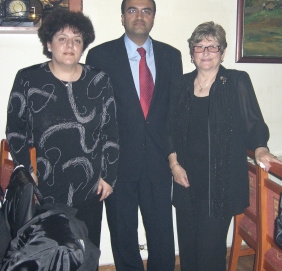IAHPC TRAVELING FELLOWSHIP REPORT
Bulgaria

Bulgaria is a southeast European country with a population of approximately 8 million people. Palliative care seems to be gaining momentum in the country. In 2004 and 2005, The Open Society Institute funded the palliative care education projects at the Medical University , College of Medicine , Plovdiv , Bulgaria . The key players were Dr Karamitreva, project leader; Associate professor Dr. Krasteva, Director of the Medical College; and Dr Penka Kolchakova a physician and lecturer at the Medical College.
The projects involved post-graduate education for nurses and basic education of nurses and midwives who train in the college. A total of 200 nurses and 70 midwives attend the college at any given time. It is important to note that the midwives also provide medical care to the population. The nurses spend 20 hours in lectures and another 40 hours in hospice/ palliative care clinics. The midwives have 20 hours of lectures and spend 10 hours in the hospice/palliative care clinics. They take an exam at the end of the training - the training is mandatory. The reference book for the exam is “ Palliative care guidelines for nurses and midwives,” and is written in Bulgarian by a multi-disciplinary team of authors from the college.
Thanks to a Traveling Fellowship grant from IAHPC, I had the opportunity to visit the Medical College campus and meet with both Dr Krasteva and Dr Kolchakova. Although funds for the college’s project have run out, they have continued the intent for which the funds were originally provided.
I was invited to give a lecture to the Medical College faculty on the current status of end-of-life care in the United States , training in the field, and its challenges. The audience included visitors from Universities from neighboring countries. I was also invited to attend the graduation day celebrations at the college and was given an opportunity to speak.
On further interactions with Dr Klochakova, I learnt that palliative care is now included in the strategic planning of healthcare policy in the country. There is a Bulgarian palliative care association. Opioids are available, but more readily in the cancer centers. Like in most countries, there is hesitancy by healthcare providers to use opioids. Interestingly, all hospice/ palliative care is self pay except for 20 days during a period of 6 months when a patient with a terminal cancer will be provided inpatient services that are funded by a National Health Insurance Fund.
I was very impressed with the dedication and vision of those involved in the project and how they continue to strive for improvement. Dr Kolchakova is considering translating the ELNEC curriculum into Bulgarian in the future. Of concern is that patient care is doctor directed and nurses may have little if any input in the care plan. I would like to thank IAHPC for giving me this opportunity and the Open Society Institute for their great work in promoting palliative care in the region.
Parag Bharadwaj, MD
Associate Medical Director
Hospice and Palliative care
Cedars-Sinai Medical Center
California
|



